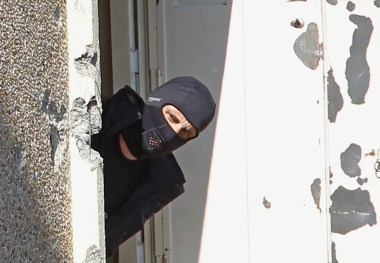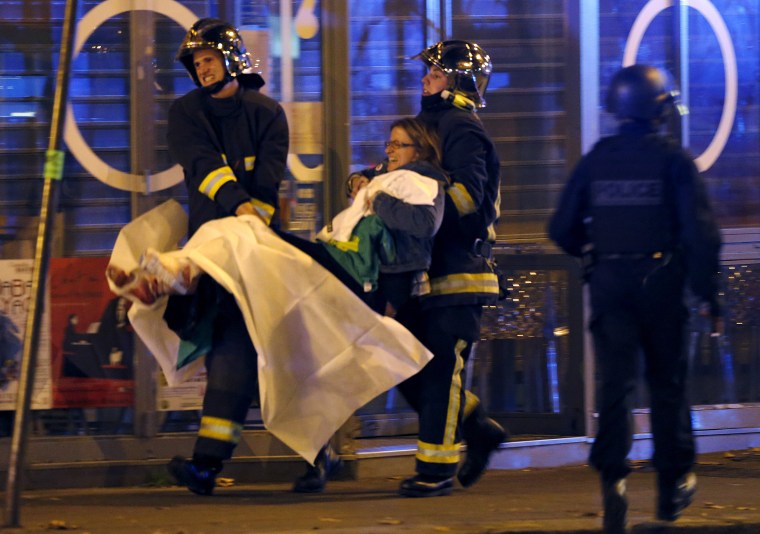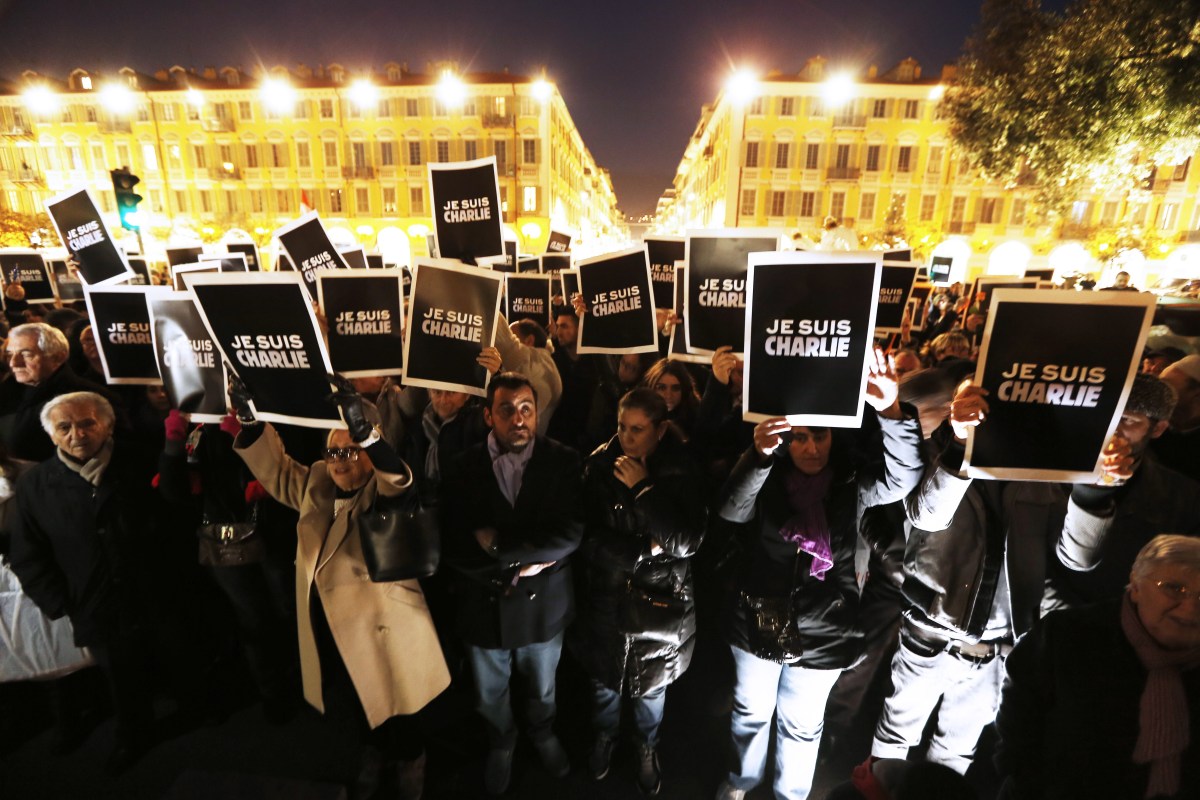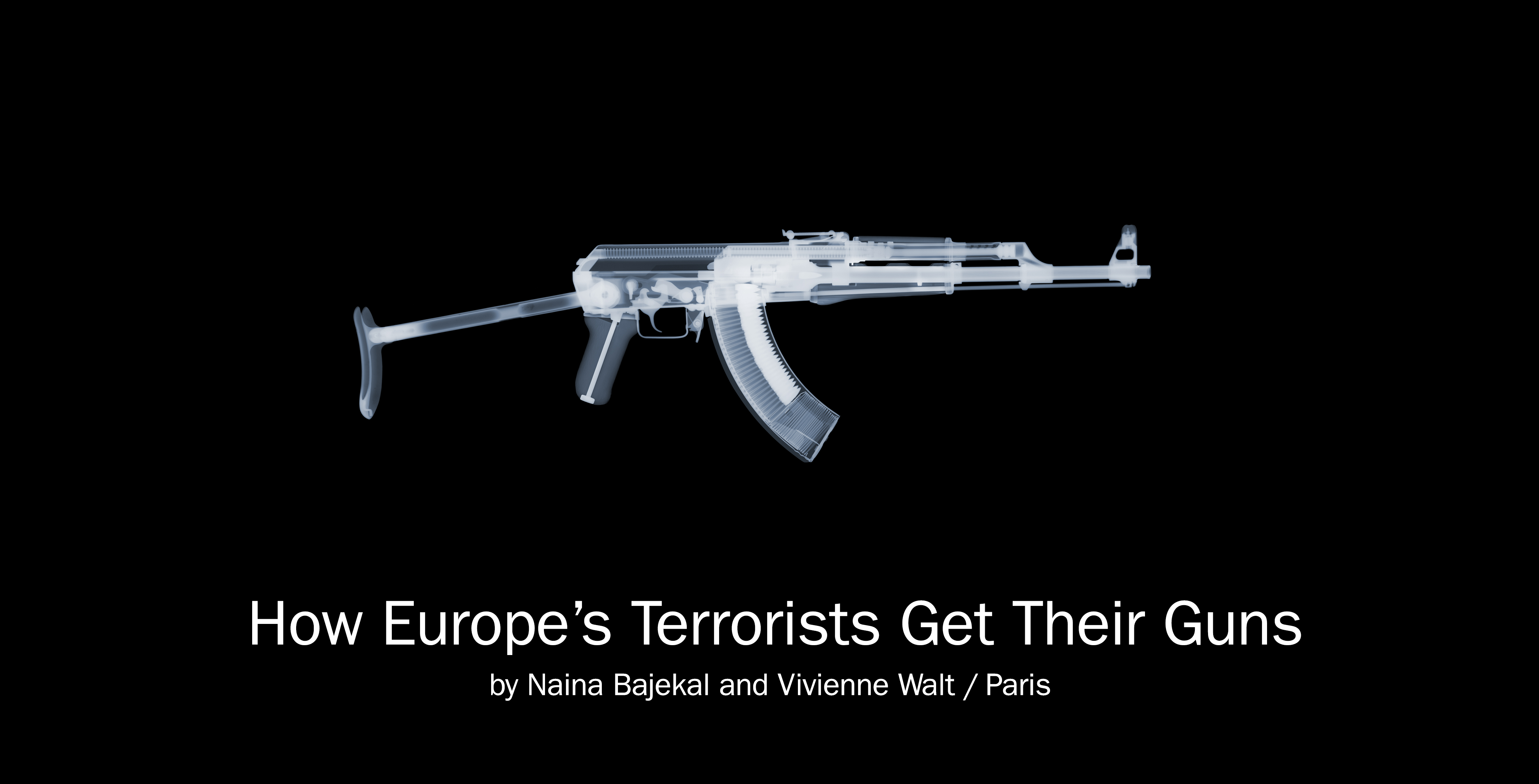
Twice this year, Parisians have witnessed attackers armed with high-powered assault weapons—the kind outlawed in France—run down Paris’s grand boulevards and unleash a bloodbath upon the City of Light. “How do these people arrive here?” asked Florent Vigneux, 26, a physiotherapist, standing stunned in the Place de la République, two days after the Nov. 13 attack. “What can our government do?”
The fear and confusion after January’s Charlie Hebdo attacks over how military-grade weapons made their way into the French capital has only worsened since the massacre on Nov. 13 carried out by ISIS supporters, which left 130 dead and injured some 350 more. In the wake of the latest attacks, fear only intensified—speaking to the French Parliament on Nov.19, Prime Minister Manuel Valls also warned that ISIS could use biological or chemical weapons to attack France. “We must not rule anything out.”
Yet it was not bombs or chemical or radioactive weapons that caused so much death and destruction, but comparatively simple rifles and assault weapons, tools of war that have already left their mark on France, and the rest of Europe.
Compared to the U.S., where 33,000 people are killed by firearms a year, more than 11,000 of them in homicides, Europe has long been seen as a safe haven from gun-related violence. Mass shootings on the continent—though not unknown—are extremely rare.
But that has been changing. Rather than the explosives used in major attacks in Madrid and London a decade ago, guns have increasingly become the weapon of choice for extremists. The first notable incident was in 2012, when Mohamed Merah shot and killed three soldiers and four Jewish civilians in the French city of Toulouse. In May 2014 Mehdi Nemmouche shot up the Brussels Jewish Center, killing four. In January this year, three gunmen shot dead 17 people in separate attacks at the offices of satirical newspaper Charlie Hebdo and a kosher supermarket. The following month, a 22-year-old Danish man sprayed a Copenhagen café with bullets, killing one, and later shot dead a Jewish security guard.

There have also been several foiled attacks involving guns: in April, a gunman preparing to attack Parisian churches accidentally shot himself in the leg and was found near a car filled with loaded weapons. In August, a young Moroccan man boarded a train en route to Paris from Amsterdam, armed with a Kalashnikov and a pistol, but was subdued by passengers after the gun jammed.
The rise in so-called “lone wolf” terrorists operating with relative autonomy partly explains the shift in tactics: guns require less expertise to use than bombs. Making and transporting a bomb requires effort and communication, which in turn leads to a higher risk of being discovered by the authorities. “The fact is that we are seeing homegrown, localized threats within communities, who know where firearms are,” Brian Donald, chief of staff of Europol, the E.U.-wide policing organization, told TIME in an interview after the Copenhagen attack in February. “They don’t have to have a big terrorist network to support them, they can go out and buy one [weapon] on the street. That is what the police in Europe are facing.”
Lone wolf attacks, though terrifying in their randomness, usually result in comparatively few casualties. More worrying is the use of firearms in coordinated attacks involving multiple gunmen. The 2008 Mumbai attacks made it clear to terrorists around the world that guns could yield significant damage. That November, 10 Pakistani militants launched bombings and shootings on train stations, hotels, cinemas and a Jewish community center, killing 164 people. “Mumbai really kicked off this kind of crime,” says Paul James, former head of the U.K.’s National Ballistic Intelligence service who is now leading an E.U.-funded project to look at how weapons cross out of the Balkans into the rest of Europe.
The Paris attackers likely took their inspiration from Mumbai, both in terms of weapons and indiscriminate soft targets. As in Mumbai, the Paris attacks involved both explosives and firearms, but it was the guns that ultimately had the most devastating effects, especially at the Bataclan theater, where gunmen killed 90 people.

Once European terrorists realized the strategic advantages of guns, they quickly discovered they were surprisingly easy to find. Just beyond the countries of Western Europe, with their restrictive gun laws, lie the Balkan states, awash with illegal weapons left over from the conflicts that raged there in the 1990s. According to the Switzerland-based Small Arms Survey, there are anywhere between three million and six million firearms in circulation in the Western Balkans—and possibly more.
Officials say the increase in foreign fighters returning from conflicts abroad—some 5,000 Europeans have joined ISIS and other jihadist groups in Iraq and Syria—is especially worrying considering the vast pool of weapons available in nearby Eastern Europe and North Africa, the detritus of past and current wars. “It’s a relatively new phenomenon, but there’s a growing number of people who have been trained to use automatic weapons, assault rifles and grenade launchers,” says Ivan Zverzhanovski, who heads the U.N. Development Program’s project in Belgrade to control small arms in southeastern and eastern Europe. “That will cross-fertilize in a way with the Balkans.”
For E.U. officials, the Paris and Copenhagen attacks this year have confirmed a suspicion that illegal weapons are flowing freely through Europe’s 26-country Schengen zone, which allows near frictionless travel across borders, and that European leaders are lagging behind in cracking down on the trade. “We have so many weapons in Paris,” Christophe Crépin, spokesman for France’s national police union, told TIME a few days after the Nov. 13 attacks. “There are links between organized crime and terrorists, and a route that goes from the Balkans.”

France became particularly worried about the trafficking of illegal guns in 2012, increasing fines and jail terms for those involved in the trafficking and possession of them. Interior Minister Bernard Cazeneuve said in September that police have seized nearly 6,000 weapons from criminal groups each year since 2013, 1,200 of which were military assault weapons. And in the three weeks following the Nov. 13 attacks, Cazeneuve said French police seized 334 weapons, 34 of them military-grade.
Several officials and experts tell TIME they’ve seen a noticeable climb in both the numbers and the types of illicit weapons crossing borders over the past few years. Rather than pistols and small guns, there has been a spike in demand for military-grade assault weapons. This reflects a very different kind of criminality: petty criminals and drug dealers tend to want small pistols that they can conceal; terrorists want AK-47s that can do maximum damage.
“For something like the Paris attacks, you don’t need hundreds of thousands of weapons. You just need enough to create havoc,” says Zverzhanovski. “The gun market operates on a very basic supply and demand system. Since about 2011, there has definitely been a significant increase of illicit weapons going from southeast Europe towards different parts of the E.U.” Crucially, it’s not truckloads or planeloads of weapons coming in. It’s much more a case of “micro-trafficking”—a few pieces being brought in by individuals—making it much more difficult to track.
Though not authorized to speak on the record, three officials and two gun experts with information on the Charlie Hebdo investigation confirmed to TIME that the weapons used in the attacks came from the Balkans and Eastern Europe. Some were deactivated weapons from Slovakia, converted to be live-firing. (Under pressure from the E.U., Slovakia recently tightened its regulations for the possession and sale of weapons). Other arms are believed to have come from Croatia and Serbia, while some ammunition has been traced to the Republika Srpska, an administrative entity in Bosnia and Herzegovina.

Some of the weapons in the Nov. 13 attacks in Paris may have followed a similar path as the Charlie Hebdo weapons. According to a report by German tabloid Bild and confirmed by sources speaking to TIME, a German national called Sascha W. sold two of the Chinese Model 56 variant of the AK47 Kalashnikov assault rifle and two Zastava M70 machine guns to “an Arab in France” on Nov. 7. French officials believe the guns were among those used in Paris on Nov. 13. The M70 rifles, standard issue guns in the former Yugoslavia, were reportedly produced in the country’s state arsenal in the late 1980s. The director of the Zastava factory in central Serbia told Reuters that his company found guns from one batch were sent to military depots in Slovenia, Bosnia and Macedonia.
As for the Chinese model AK47s, experts speaking to TIME point out that such copies have in fact been produced in Albania from the 1960s until fairly recently, notably in the town of Gramsh in central Albania. And there appear to be many more signs of a Balkan weapons pipeline to Western Europe. Shortly before the Paris attacks, police in southern Germany arrested a Montenegrin man with eight Kalashnikovs sealed into the body of his car; his satellite navigation system showed a Paris address as its destination. Although German authorities have not confirmed any link to the Paris attacks, for some it underscored how big a problem the unchecked spread of Balkans weapons had become.
“European security forces have been slow to recognize that there is a widespread problem arising out of the huge amounts of assault rifles and ammunition left unaccounted for after the various Balkan upsets,”says Brian Johnson-Thomas, an arms trafficking expert who has worked for the UN Security Council and the European Commission on tracking guns from the Balkans into the rest of Europe.
How can investigators track the flow of illegal guns? When a weapon is fired, the bullet leaves a trace as unique as a fingerprint on its cartridge case. “If you recover the cartridge or the bullet, you would be able to say it definitely came from a particular gun,” says Paul James, the former British police investigator. But knowing which gun a bullet came from is very different from being able to work out exactly where that gun was manufactured—and where it might have traveled before it was used in an attack. “Many guns still in circulation now were manufactured in the 1970s and 1980s—especially the reliable and popular Kalashnikovs,” says Stefano Caneppele of Transcrime, a Milan-based research center.
In December 2014, Caneppele began a two-year project funded by the European Commission to gather data on illicit guns trafficking, bringing together E.U.-wide knowledge about firearms. He says because guns last for decades, the market for them is much more difficult to track than drugs or cigarettes, which are consumed in large and repeated quantities that require regular resupplying
The Kalashnikov’s long lifespan also means the line separating legal and illegal guns trade is often blurred. “Manufacturing of firearms is almost always done according to the law,” says Pensala, the Finnish police officer. “But if you think about the lifespan of a Kalashnikov, at some point it drops from the legal market to the illegal one. Especially in Eastern European countries, corruption is one of the main reasons for that. There’s a joke in certain gun factories that when you manufacture weapons, one is for the government and one is for you.”
The illegal reactivation of Kalashnikovs is often made possible by the sale of gun parts on the Internet and within Europe too. Pensala points out that the neighborhood of Molenbeek in Brussels—the Belgian suburb that became a hub for Islamist terror—has even earned the nickname “The Great Bazaar of Kalashs.” As demand for Kalashnikovs soars, so do prices. An AK-47 bought for four or five hundred euros in the Balkans could sell for thousands within the E.U., where gun laws are so much more restrictive.

During the raid of German national Sascha W.’s house, police officers reportedly found 16 weapons and a spokeswoman for the Stuttgart prosecutors office told Deutsche Welle that Sascha W. “was allegedly converting non-lethal weapons to firearms and then selling them online.” Analysts say Sascha W. appears to be part of a growing—and disturbing—trend of illegal gunsmiths preparing weapons by themselves with spare parts available on the Internet, and then selling assault rifles to terrorists. “His actions point strongly and typically to reactivation business,” says Pensala, the Finnish police officer.
If Sascha W. was indeed selling blank-firing guns and gas guns, which can then be converted into active guns with the right parts, his activities were similar to how some of the guns used in the Charlie Hebdo attack were procured and converted in Slovakia. And the fact that every E.U. member state has slightly different laws on firearms and the standards for deactivation means a deactivated gun that is legally sold in Germany or Slovakia could be converted to live-firing and used elsewhere.
What the Paris attacks made clear is that European authorities are struggling to catch up with a phenomenon that suddenly outpaced them. Those working on gun control say law enforcement agencies only really began paying attention to the phenomenon of illicit arms trafficking after 2011, when some European governments started to notice increasing numbers of illegal guns found in spot checks. Since then, the rise of terror-linked shootings has prompted closer collaboration between European countries: in 2013, the European Commission made tackling gun violence a priority. But intelligence on the size of the market and how organized crime and gunrunning networks function is still fairly patchy, particularly with regards to sharing information with the Balkan nations.
Europe’s free borders remain a barrier to stopping the flow of guns. “The problem generally is that as the E.U.’s frontiers have moved eastward, certain countries with weaker gun laws have moved inside the free-movement zone,” says arms trafficking expert Johnson-Thomas. “That doesn’t always help with law enforcement.”
That may finally change. Already on Nov. 18 the European Commission adopted a package of measures including stricter rules on the ban of certain semi-automatic weapons and the sale of firearms online, as well as more rigid regulations for the sale of deactivated guns. The Commission is also developing an action plan involving the Balkans on the illegal trafficking of weapons and explosives. “The recent terrorist attacks on Europe’s people and values were coordinated across borders, showing that we must work together to resist these threats,” the Commission’s president Jean-Claude Juncker told the E.U. body in Brussels, just five days after the Paris attacks, when it voted to tighten gun laws in Europe.
The recent Paris attacks seem to be a wakeup call for European authorities to share information and work more closely with the Balkan states to stem the flow of weapons. But with failed states at the edge of Europe’s borders and stockpiles of guns floating around in unstable regions like Libya and Ukraine, the continent’s struggle is likely to be a long one.
